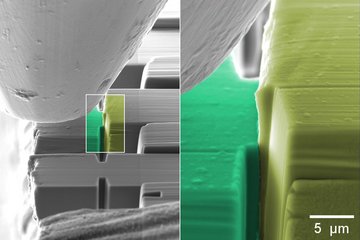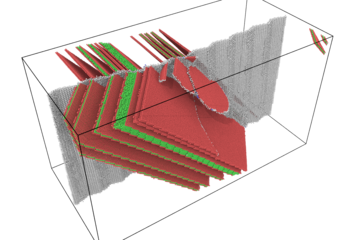All genres
1.
Journal Article
Microstructure-sensitive crystal plasticity and phase-field modeling of deformation and fracture in polycrystalline ice. Acta Materialia 283, 120512 (2025)
2.
Journal Article
Controlling Sodium Dendrite Growth via Grain Boundaries in Na3Zr2Si2PO12 Electrolyte. Advanced Energy Materials 14 (20), 2304488 (2024)
3.
Journal Article
Chemo-mechanical failure mechanisms of the silicon anode in solid-state batteries. Nature Materials 23 (4), pp. 543 - 551 (2024)
4.
Journal Article
Effect of Pore Formation on Redox-Driven Phase Transformation. Physical Review Letters 130, 168001 (2023)
5.
Journal Article
Chemo-Mechanical Phase-Field Modeling of Iron Oxide Reduction with Hydrogen. Acta Materialia 231, 117899 (2022)
6.
Journal Article
Hierarchical nature of hydrogen-based direct reduction of iron oxides. Scripta Materialia 213, 114571 (2022)
7.
Journal Article
Interphase Formed at Li6.4La3Zr1.4Ta0.6O12/Li Interface Enables Cycle Stability for Solid-State Batteries. Advanced Functional Materials 32 (20), 2112113 (2022)
8.
Journal Article
Modeling and simulation of microstructure in metallic systems based on multi-physics approaches. npj Computational Materials 8, 93 (2022)
9.
Journal Article
A chemo-mechanical damage model at large deformation: numerical and experimental studies on polycrystalline energy materials. International Journal of Solids and Structures 228, 111099 (2021)
10.
Talk
Phase-field model for Hydrogen based direct reduction of iron oxides: Role of porosity. TMS - Algorithm Development in Materials Science and Engineering, Orlando, FL, USA (2024)
11.
Talk
The chemical, thermodynamic and kinetic roles of pores in the hydrogen-based direct reduction of single-crystalline wüstite into iron. EUROMAT 2023, Frankfurt, Germany (2023)
12.
Talk
Sustainable Metals. Virtual Keynote Perspective Lecture, Materials Chain and Materials Science Department, RUB
, Bochum, Germany (accepted)
13.
Preprint
Effect of Pore Formation on Redox-Driven Phase Transformation. arXiv (2022)











